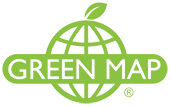For nearly 30 years, Green Map has been an anchor in the Metro NYC nonprofit mapping community. Led by its original founder, Wendy Brawer, Green Map’s portfolio of work and advocacy in locally-led mapping and sustainability efforts is quite impressive. Since the launch of the Green Map System by Wendy Brawer in 1995 and publication of the original Green Map of NYC through her eco-design company, the program’s engagement tools and mapping resources have been adapted by locally-led projects in 65 countries. Many joined the Green Map network when Greenhouse – their first content-managed website – was activated in 2007. The site grew to become a rich resource highlighting community developed mapping work in all parts of the world.

While “green” mapping was one of its early defining products and focus, the organization has expanded its services to include interactive web mapping, education, multimedia, event coordination, workshops, tours, planning and consulting, and creating software development tools.
Community Engagement Maps and Tools
Green Map’s award-winning icons, tools, platform(s) and tutorials help create engaging and visually powerful mapping content used as guides for local nature, culture, community living, social justice and resources for sustainable living. In addition to providing tools and tutorials on making maps, Green Map promotes their mapping efforts as part of Project Stories. Project Stories are locally written and use tags to categorize the story type, theme, and purpose. Users can discover how Green Map projects were created, people and organizations involved and about the project’s impact on their community. Green Map projects are tagged and can be searched as part of the following 11 categories:

Besides its own mapping platform (with version 2 of the Open Green Map now in beta), the program also offers suggestions and tutorials on how to promote the use of the Green Map icons in other interactive mapping platforms such as ArcGIS Online (Story Maps), CARTO, Google Maps, Google Earth, and the Map of Tomorrow.
